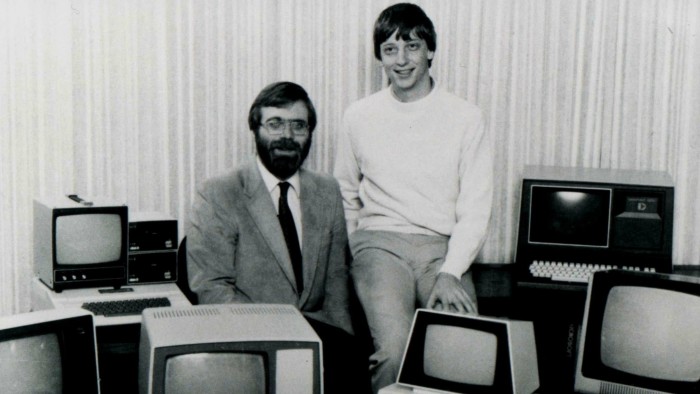Unlock the Editor’s Digest for free
Roula Khalaf, Editor of the FT, selects her favourite stories in this weekly newsletter.
When Bill Gates and Paul Allen founded the company they called Micro-Soft 50 years ago this week, it was to sell a version of the Basic computer language for the Altair, the first proto-PC.
Their first product set the pattern for what was to follow. Microsoft’’s fortunes soared, stagnated and soared again with the tech industry’s periodic platform shifts. But the heart of its business always lay in providing developers with tools to build their applications and platforms to run them on.
With a globe-spanning fleet of data centres under its control, Gates and Allen’s company has come a long way from the Altair. Thanks to a well-placed early bet on generative AI, it enjoyed a notable boom as its mid-century loomed. But the outcomes of platform shifts in the tech industry are not always predictable, and it is still too soon to tell if Microsoft has seen off the potential threats from this one.
Thirty years ago, when the company was at the height of its PC dominance and heading for a showdown with Washington over its anti-competitive tactics, the rise of the internet loomed as an existential threat. If developers could build their applications to run inside web browsers, as internet pioneer Netscape dreamt, then who would need to pay for Microsoft’s Windows? A PC running on the Linux open-source operating system would do just as well.
In the event, Microsoft squashed Netscape — contributing to its antitrust woes. But it wasn’t the web that diluted its dominance over the tech world. Instead, smartphones took centre stage, pushing PCs to the sidelines and bringing a new generation of mobile app developers to the fore. The emergence of the cloud also eroded the importance of the PCs and PC-like servers Microsoft was focused on, leaving its stock price in a protracted lull.
In the event, Satya Nadella, who was elevated to the CEO seat in 2014, succeeded in breaking the company’s reliance on the PC. He began by offering developers whatever tools they wanted through the cloud, including the open-source software that former chief executive Steve Ballmer had once called a cancer on the tech industry. The close alliance with OpenAI that Nadella forged in 2019 extended that run, giving Microsoft exclusive rights to offer the start-up’s AI models through its cloud platform.
Adaptability has been one of the hallmarks of Nadella’s leadership at Microsoft — something he has shown again as the generative AI market goes through convulsions. Despite the tie with OpenAI, the Microsoft CEO was quick to see how models like these might commoditise even the most advanced AI technology. Microsoft was one of the first to back Meta’s open model, Llama, and was offering access to DeepSeek’s R1 reasoning system less than two weeks after its launch.

Yet it is still too early to judge the full extent of the upheaval from generative AI, or Microsoft’s ability to withstand this latest disruptive storm. Like other Big Tech transitions, it is likely to open the door to new competitors and could completely overturn the way Microsoft’s customers develop and run applications.
Nvidia, for instance, owes part of its dominance in AI chips to its Cuda software, which makes it easier for developers to create applications that run on its hardware. As competition in AI chips starts to build, Nvidia’s eyes have turned to adding more valuable software services to its portfolio.

Then there is OpenAI. Its strategy has put it on a clear collision course with Microsoft. Though ChatGPT has become an accidental consumer tech giant, OpenAI’s main aim has been to build the central platform for the AI age itself. If OpenAI succeeds in its dream of creating a greater-than-human level of intelligence, then all bets are probably off: It is hard to see which companies’ strategies could withstand such a powerful force. But even short of that, if developers come to lean more heavily on advanced forms of AI to develop their applications, then large language models could become the new developer platform. Like the browser in the early days of the internet, that could shake Microsoft to its foundations.
Other outcomes are possible, though. For now, rather than a new platform in its own right, generative AI has been an extension of the computer industry’s cloud era. If that remains the case, it would continue to play to Microsoft’s strengths.
Since Nadella took over, in early 2014, its share price has soared tenfold, lifting its stock market value to nearly $2.8tn. There is plenty to celebrate from the first half-century.
